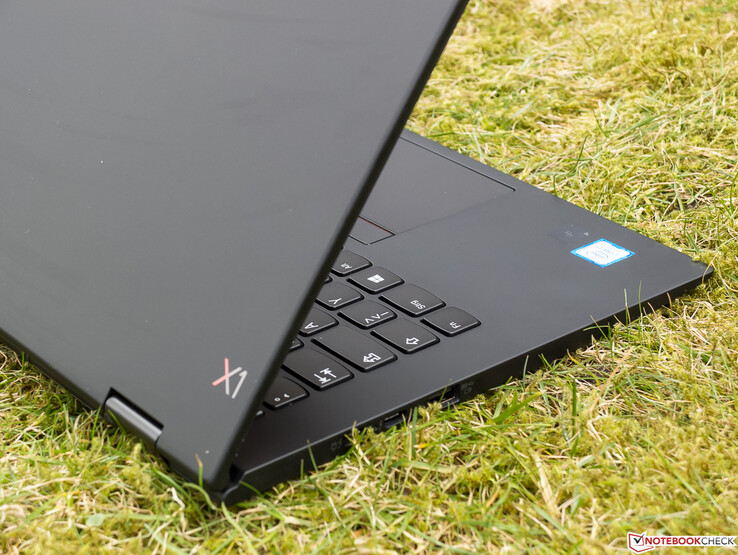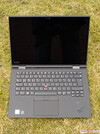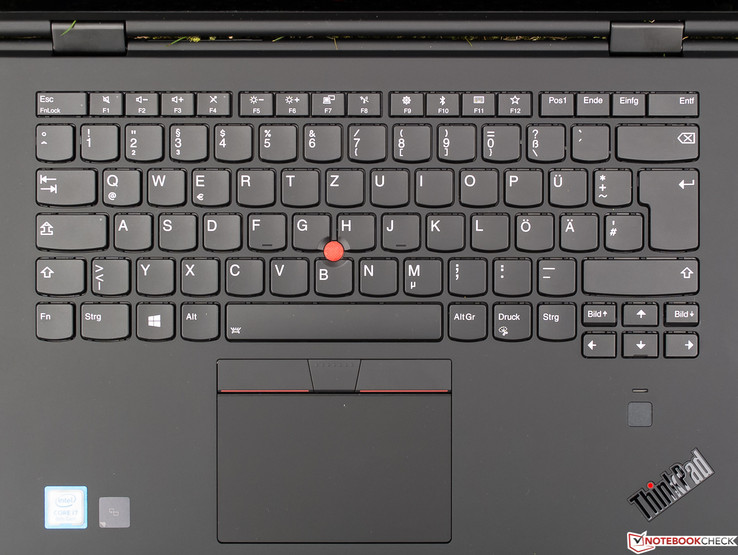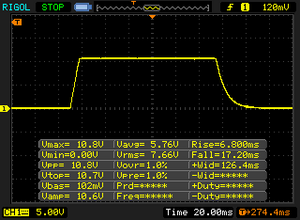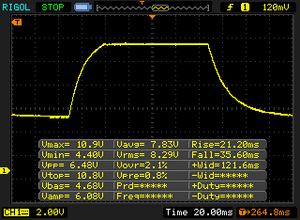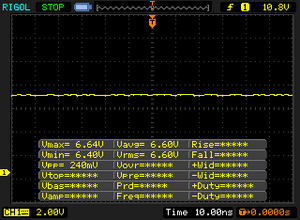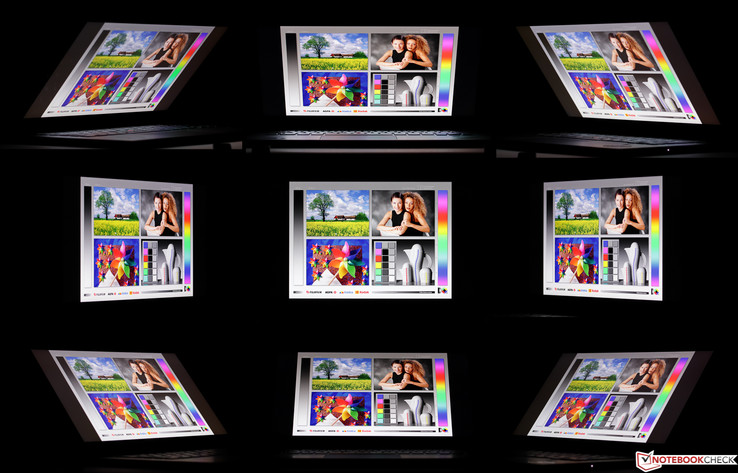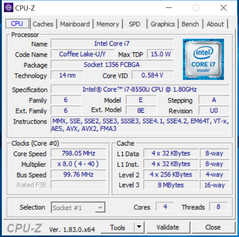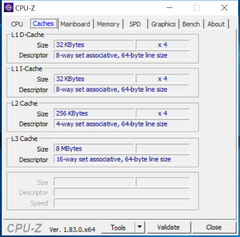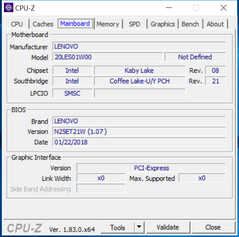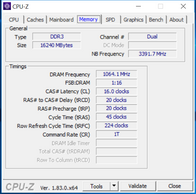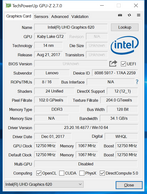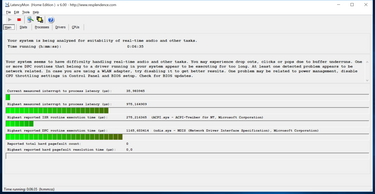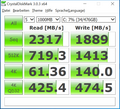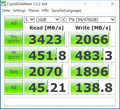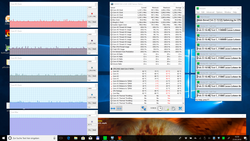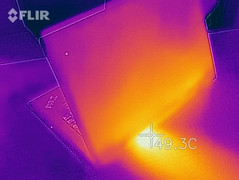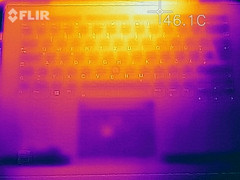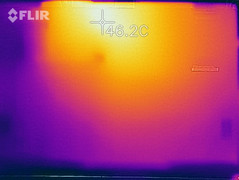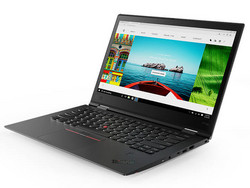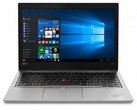Lenovo ThinkPad X1 Yoga 2018 (i7-8550U, HDR WQHD) Convertible Review

The new Lenovo ThinkPad X1 Yoga 2018 is a high-quality, high-performance, but also high-priced 14-inch office convertible that combines the strong points of the ThinkPad series with the flexibility of a convertible and even has a special slot for the stylus that comes with the device. This is the third generation of the ThinkPad X1 Yoga and the direct successor of the 2017 model. You can find a list of all available configurations here. The case, input devices, lavish, up-to-date port selection and security features (TPM and fingerprint reader) remain the same in every configuration.
Our test unit is a special configuration from Campuspoint. It is equipped with the quad-core Intel Core i7-8550U, 16 GB of RAM, a 14-inch WQHD IPS display with Dolby Vision HDR technology and a 512-GB SSD. The business convertible weighs 1.4 kg (~ 3.08 lbs) in this configuration.
The choice of suitable comparison devices for this review includes our test unit's predecessor, but also 13-inch and 12.5-inch devices, in order to have suitable competitors in the area of purpose and price. We have chosen the following convertibles for today's comparison field:
- Lenovo ThinkPad X1 Yoga 2017 20JES03T00 (predecessor, 14-inch)
- Microsoft Surface Book 2 (13.5-inch)
- HP EliteBook x360 1030 G2 (13.3-inch)
- Toshiba Portégé X20W-D-10R (12.5-inch)
Case: a stable and lightweight ThinkPad X1 thanks to carbon fiber
We did not notice any big changes to the black, wedge-shaped case compared to its predecessor. The largest differences are in the hinges, the port selection and the two ThinkPad logos, which are now black instead of silver. The X1 Yoga 2018 is immediately recognizable as a ThinkPad due to its red TrackPoint, the unusual touchpad build, the striking logos, the ThinkPad keyboard, as well as the soft-touch cover that attracts fingerprints, but has a very nice feel. The case is made from light-weight hybrid carbon fiber.
The base unit can be warped minimally under strong pressure and makes slight creaking noises. The display cover, which opens to 360°, is quite stable, but not pressure resistant. The overall stability is decent. It is not possible to open the device with one hand; Lenovo has obviously preferred giving the device strong hinges that ensure stable positioning in any mode. The keyboard automatically retracts into the base unit at an opening angle of 270° and above. This creates a more or less smooth surface and the keys cannot be pressed anymore, which improves handling in tablet mode. The workmanship appears to be good and rounds off our general impression of a high-quality case nicely.
As most of our comparison notebooks are 13-inch devices, while the X1 Yoga 2018 has a 14-inch screen, we have also included the 14-inch Asus ZenBook 3 Deluxe, which claims to be very compact, into our size comparison. We have also left out the Toshiba Portégé (12.5-inch) in this particular comparison. It is easy to see that unlike Asus, Lenovo has not put compact size high on its list of requirements. The same can be said for its predecessor from last year, which has an identical footprint while being a little thicker than today's test unit.
The slim MS Surface Book 2 is the longest and thickest device of our comparison (height of 23 mm/~0.9 in). The Asus ZenBook 3 Deluxe requires the least space and is only 12.9 mm (~0.5 in) thick, while the second place is taken by the HP EliteBook x360 G2, which is only 2 mm (~ 0.07 in) thicker.
Connectivity: X1 Yoga with 2 Thunderbolt over USB Type-C ports
The port selection is lavish and leaves absolutely nothing to be desired. Apart from HDMI, audio and NFC, the device also offers no less than 2 USB 3.0 Type-A ports and 2 USB 3.1 Gen2 Type-C ports, which both support Thunderbolt 3 (4 lanes) and DisplayPort. This will please not only users who enjoy using (several) external screens with resolutions of up to 4K. Lenovo has included an RJ45 adapter for the proprietary mini-Ethernet port. Even port zombie VGA has taken care of by adding an HDMI-to-VGA adapter to the box. The device is not compatible with Lenovo's new SideDock connector.
The positioning of this marvelous port selection is not perfect, but not a big issue either. At least there cannot be any collisions with cables or sticks towards the front of the sides.
SD Cardreader
In line with the stellar port selection, the UHS-II-capable SD card reader, which seems to be connected via PCIe, does an excellent job and is among the top 10 fastest card readers of or database in the JPG copy test. This is not the case for sequential reading, but the Lenovo ThinkPad Yoga still reaches great rates in this area as well. Its predecessor, on the other hand, was rather slow and only reached USB 3.0 speeds. Not only photographers will appreciate this great improvement. All our measurements were made with our reference card, the Toshiba Exceria Pro SDXC 64 GB UHS-II. We do have to criticize the placement of the SD card reader, as it is hidden behind a cover at the back of the device.
| SD Card Reader | |
| average JPG Copy Test (av. of 3 runs) | |
| Lenovo ThinkPad X1 Yoga 2018-20LES01W00 (Toshiba Exceria Pro M501) | |
| Microsoft Surface Book 2 (Toshiba Exceria Pro SDXC 64 GB UHS-II) | |
| Lenovo ThinkPad X1 Yoga 2017 20JES03T00 (Toshiba Exceria Pro M401) | |
| Average of class Convertible (28.1 - 209, n=23, last 2 years) | |
| maximum AS SSD Seq Read Test (1GB) | |
| Microsoft Surface Book 2 (Toshiba Exceria Pro SDXC 64 GB UHS-II) | |
| Lenovo ThinkPad X1 Yoga 2018-20LES01W00 (Toshiba Exceria Pro M501) | |
| Average of class Convertible (28.9 - 253, n=22, last 2 years) | |
| Lenovo ThinkPad X1 Yoga 2017 20JES03T00 (Toshiba Exceria Pro M401) | |
Communication
Lenovo has made a good choice in the area of wireless communications as well, and has treated the new ThinkPad X1 Yoga with the tried and tested Intel Dual Bank Wireless-AC 8265, which reaches a maximum gross transmission rate of 867 MBit/s thanks to its MIM 2x2 antenna construction, and includes Bluetooth 4.2. If you take into account the usual overhead of about 200 MBit/s, the test unit shows very good, although not perfect, transmission rates when connected to our reference router Linksys EA8500 (distance of 1 meter/~3.3 ft).
Like most other competitors, the X1 Yoga 2018 is a little weaker when sending data. The Toshiba Portégé X20W shows that more is possible, although this device has rather disappointing speeds when receiving data.
Security
The security features include an up-to-date TPM 2.0 chip as well as a fingerprint reader, although this played up a little when setting up Windows Hello. Nonetheless, it locks and unlocks the convertible quickly and reliably. If you decide to get the Windows 10 Pro version, you will also be equipped with the BitLocker hard drive encryption feature. If you worry about the webcam being active by mistake, or being hacked, you can slide the ThinkShutter over and simply block its vision.
Accessories
Apart from the obligatory power supply and QuickStart guide, our test unit also comes with two adapters, one for HDMI to VGA and one for mini Ethernet to RJ45, as well as a stylus that can be inserted into the case. Lenovo does not offer further accessories specific to the Lenovo ThinkPad X1 Yoga.
Maintenance
Due to the lack of maintenance hatches and the fact that the battery is not accessible from outside, any maintenance work will require the removal of the bottom cover, which is held in place by eight Philipps screws. This should not pose any difficulties, but could affect warranty. As our test unit is on loan, we have not tried to take it apart. The RAM is firmly soldered on and cannot be expanded (nor does it need to be). The device does not have room for additional storage devices either. You can take a look at the insides of our device's predecessor here.
Warranty
Lenovo offers a three-year on-site warranty for the ThinkPad X1 Yoga 2018. Please see our Guarantees, Return Policies and Warranties FAQ for country-specific information.
Input devices for frequent typers and lovers of the Lenovo ThinkPad TrackPoint
Keyboard
Like every ThinkPad keyboard, the X1 Yoga's keyboard has some layout particularities. In this case, the position of Fn and Ctrl at the bottom left have been exchanged, but they can easily be switched back to their usual positions in the BIOS/UEFI. The print key, on the other hand, has been repositioned to the same area, and now lies between AltGr and Ctrl. This has enabled the more important "delete" key to take up some extra space. The arrow keys as well as pg up and down each only occupy the space of half a normal key and are placed in a separate block to the bottom right of the keyboard. The "escape" key has been assigned a useful secondary function as Fn lock, which means that you can use the function keys without having to hit Fn every time. This can be quite useful while gaming, for example. However, there is no "pause" button.
The main keys, unlike the function keys, are slightly concave and the lettering is very easy to read. Some keys, such as Fn lock, additionally feature a status LED. We are also happy with the even, two-level backlighting. Although it could be a bit brighter for our taste, it lights up the keyboard decently when working in dark surroundings. As we would expect from a ThinkPad keyboard, the typing experience is very satisfying and gives an impression of high quality. While the pressure point is not the hardest, it is still nicely noticeable. Subjectively, we are very happy with the way keys feel only lightly springy. Thanks to the keys regular width, size and gap distances, experts of the ten-finger method should reach their full potential on this keyboard. Only an unrealistic amount of pressure can cause the keyboard to give way a little. As long as you are not literally hammering at the keyboard, typing is rather quiet.
Touchpad
Again, we are looking at a ThinkPad-typical design. The bottom of the touchpad is a ClickPad, which is additionally complemented by three dedicated mouse keys at the top and are intended to be used in combination with the TrackPoint. The Clickpad has an unusually wide area at the sides where it does not react to initial touches. This can be turned off in the Synaptics control panel.
Gliding works well on the impeccably smooth surface, even when your fingers are damp. The touchpad also offers good precision and is very responsive. The two ClickPad mouse buttons have very short travel, are quite crisp and offer comfortable resistance. Only the acoustic feedback is a little disappointing. The same can be said for the rather soft keys above the ClickPad. You can configure gestures with up to four fingers via the Windows 10 settings; the driver also offers several other configuration options. Drag&Drop via a double tap works reliably.
Touchscreen
The 10-point touchscreen reacts quickly and precisely, even in the corners. However, sliding movements with damp fingers feel uncomfortable, because they seem to "stick" to the glass surface.
Display: WQHD and Dolby Vision HDR on the Lenovo X1 Yoga
One of the many highlights of the new Lenovo X1 Yoga is, of course, the 14-inch Dolby Vision HDR display with a resolution of 2160x1440 (WQHD, 185 ppi). As it is a touchscreen, the display is reflective. The same panel has already been tested in the new Lenovo ThinkPad X1 Carbon 2018, so please take a look at our review of that device for general remarks on the panel.
Unlike for the predecessor's OLED screen, Lenovo has not used PWM in this device. The average brightness is 522 cd/m², which is great for a notebook and even beats the already great luminosity of the Toshiba Portégé. The X1 Yoga 2017 cannot even reach half that value. Brightness distribution is fine, but there is quite a bit of clouding in the corners on all-black content, and blacks generally do not appear very deep. Alternatively, the convertible is also available with a Full-HD IPS panel and a usual WQHD IPS panel.
| |||||||||||||||||||||||||
Brightness Distribution: 86 %
Center on Battery: 567 cd/m²
Contrast: 1873:1 (Black: 0.3 cd/m²)
ΔE ColorChecker Calman: 2.8 | ∀{0.5-29.43 Ø4.77}
ΔE Greyscale Calman: 4.5 | ∀{0.09-98 Ø5}
100% sRGB (Argyll 1.6.3 3D)
88.9% AdobeRGB 1998 (Argyll 1.6.3 3D)
99.4% AdobeRGB 1998 (Argyll 3D)
100% sRGB (Argyll 3D)
86.5% Display P3 (Argyll 3D)
Gamma: 2.16
CCT: 7205 K
| Lenovo ThinkPad X1 Yoga 2018-20LES01W00 Lenovo 40AE / B140QAN02.0, , 2560x1440, 14" | Lenovo ThinkPad X1 Yoga 2017 20JES03T00 LEN4140, , 2560x1440, 14" | HP EliteBook x360 1030 G2 CMN1374, , 1920x1080, 13.3" | Microsoft Surface Book 2 Panasonic MEI96A2 , , 3000x2000, 13.5" | Toshiba Portege X20W-D-10R Toshiba TOS508F, , 1920x1080, 12.5" | |
|---|---|---|---|---|---|
| Display | -23% | -19% | -18% | ||
| Display P3 Coverage (%) | 86.5 | 65.5 -24% | 67.9 -22% | 68.7 -21% | |
| sRGB Coverage (%) | 100 | 88.8 -11% | 95.7 -4% | 96.8 -3% | |
| AdobeRGB 1998 Coverage (%) | 99.4 | 64.9 -35% | 69.4 -30% | 70.4 -29% | |
| Response Times | 91% | -5% | -9% | -41% | |
| Response Time Grey 50% / Grey 80% * (ms) | 56.8 ? | 3.6 ? 94% | 55.2 ? 3% | 52.8 ? 7% | 67 ? -18% |
| Response Time Black / White * (ms) | 24 ? | 3.2 ? 87% | 27.2 ? -13% | 30 ? -25% | 39 ? -63% |
| PWM Frequency (Hz) | 240.4 ? | ||||
| Screen | -29% | -36% | 7% | -30% | |
| Brightness middle (cd/m²) | 562 | 243 -57% | 262 -53% | 385 -31% | 442 -21% |
| Brightness (cd/m²) | 522 | 240 -54% | 256 -51% | 372 -29% | 410 -21% |
| Brightness Distribution (%) | 86 | 95 10% | 83 -3% | 89 3% | 86 0% |
| Black Level * (cd/m²) | 0.3 | 0.25 17% | 0.21 30% | 0.22 27% | |
| Contrast (:1) | 1873 | 1048 -44% | 1833 -2% | 2009 7% | |
| Colorchecker dE 2000 * | 2.8 | 5.3 -89% | 5.13 -83% | 1.6 43% | 5.22 -86% |
| Colorchecker dE 2000 max. * | 5.8 | 8.9 -53% | 9.46 -63% | 4.5 22% | 11.84 -104% |
| Greyscale dE 2000 * | 4.5 | 3.7 18% | 6.23 -38% | 1.5 67% | 7.88 -75% |
| Gamma | 2.16 102% | 1.78 124% | 2.45 90% | 2.22 99% | 2.51 88% |
| CCT | 7205 90% | 6202 105% | 6413 101% | 6502 100% | 6756 96% |
| Color Space (Percent of AdobeRGB 1998) (%) | 88.9 | 84.8 -5% | 57.84 -35% | 64 -28% | 64 -28% |
| Color Space (Percent of sRGB) (%) | 100 | 100 0% | 88.57 -11% | 95.9 -4% | 97 -3% |
| Total Average (Program / Settings) | 31% /
-5% | -21% /
-30% | -7% /
-0% | -30% /
-29% |
* ... smaller is better
Despite our personal impression, the measured black value is actually quite decent at 0.3 cd/m², although all competitors in this test field manage even lower values. Combined with the great brightness, this creates a very good contrast ratio of 1873:1. The fact that two of the darker competitors have almost the same, if not better contrast ratios is due to their particularly low black values.
When looking at color display, we first noticed that the color temperature ex-works is much too high (over 7200 K, ideal: 6500K), which causes a slight blue cast. This and the general color display can be improved by installing our color profile available for download above. As the small standard sRGB color space is displayed fully, the test unit is also suitable for non-professional image processing after calibrating and profiling.
We did the outdoor test on a day with overcast sky, so the conditions were less difficult than in direct sunlight. On the left photo, you can see a worst-case scenario, where the sky is strongly reflected on the screen. On the right, you can see the shadow made by the tester. Based on our experience, we would say that this particularly high brightness will have a positive effect and that the reflections should be a lot less strong than on a screen with only 300 cd/m². But under direct sunlight, even this brightness level can probably not prevent reflections. The left image, which we took with our back to the front door, would have looked the same even with the sun shining.
Display Response Times
| ↔ Response Time Black to White | ||
|---|---|---|
| 24 ms ... rise ↗ and fall ↘ combined | ↗ 6.8 ms rise | |
| ↘ 17.2 ms fall | ||
| The screen shows good response rates in our tests, but may be too slow for competitive gamers. In comparison, all tested devices range from 0.1 (minimum) to 240 (maximum) ms. » 53 % of all devices are better. This means that the measured response time is worse than the average of all tested devices (20.2 ms). | ||
| ↔ Response Time 50% Grey to 80% Grey | ||
| 56.8 ms ... rise ↗ and fall ↘ combined | ↗ 21.2 ms rise | |
| ↘ 35.6 ms fall | ||
| The screen shows slow response rates in our tests and will be unsatisfactory for gamers. In comparison, all tested devices range from 0.165 (minimum) to 636 (maximum) ms. » 94 % of all devices are better. This means that the measured response time is worse than the average of all tested devices (31.6 ms). | ||
Screen Flickering / PWM (Pulse-Width Modulation)
| Screen flickering / PWM not detected | |||
In comparison: 53 % of all tested devices do not use PWM to dim the display. If PWM was detected, an average of 8080 (minimum: 5 - maximum: 343500) Hz was measured. | |||
The Lenovo ThinkPad X1 Yoga 2018 display has great viewing angles even for an IPS screen. The unavoidable loss in brightness and contrast only starts to apear at very wide viewing angles and is not too strong either. Colors remain more or less the same from any angle. This is basically as good as it gets.
Performance: the Lenovo ThinkPad Yoga picks up its pace thanks to four cores and an NVMe SSD
Processor
The Intel Core i7-8550U (4x 1.8 - 4 GHz, hyper-threading, TDP 15 W) is a ULV quad-core processor from the current Kaby Lake Refresh generation, which, for the first time, combines four physical cores with a low TDP of 15 watts. Its maximum turbo clock rate of 4 GHz makes it potentially the fastest ULV quad-core processor that Intel currently has to offer after the i7-8650U (4x 1.9 - 4.2 GHz). Apart from a DDR4 memory controller, the chip, which was first presented in August 2017, also features the integrated Intel UHD Graphics 620.
The performance of the i7-8550U can vary depending on the cooling system as well as duration and type of load. This did not apply in the same way to ULV dual-cores from the recent Kaby Lake generation, as they often did not reach their TDP. The model in our test unit shows this nicely: During the first run of our Cinebench loop, the device reached a great score of 678 points. But the second round already saw rates drop to about 644 points, where the results remained (more or less) for the next few rounds.
The wide fluctuations which are typical for the Kaby Lake Refresh series begin in round 10. But even in the rounds with very low results, the turbo still seems to be used in part and the X1 Yoga remains significantly faster than it could have been with the last version's top-quality ULV i7-7660U. Lenovo has clearly succeded at implementing this CPU. On battery, the device reached a Cinebench R15 score of 538 points.
System Performance
There is not much to analyze when comparing the very similar scores that the convertibles in this comparison received from the PCMark 8 benchmark. All devices perform on a high level and neither the quad-core devices, nor those with particularly fast SSDs manage to separate themselves from the crowd. The subjective differences we felt should conform with the measured results.
Subjectively, the absolutely smooth operation with lightning-fast OS and program starts that can keep up with the speeds of gaming devices with fast storage, an NVMe SSD and 45-watt-TDP processor, are absolutely worth the high price of the ThinkPad.
| PCMark 8 Home Score Accelerated v2 | 3824 points | |
| PCMark 8 Work Score Accelerated v2 | 4719 points | |
| PCMark 10 Score | 3829 points | |
Help | ||
Storage Devices
As the SSD benchmark AS SSD cannot cope with the lavish 512-GB NVMe SSD Samsung PM981, connected via PCIe, we have based our results on the tried and tested CrystalDiskMark 3.0 and also ran the CrystalDiskMark 5.2, although these results are mainly interesting for servers (Q32T1).
Let us not waste too much time here: The SSD in the Lenovo ThinkPad X1 Yoga 2018 is extremely fast, as you can see from its sequential read rates of 1889 MB/s and the short throughput for reading small, dispersed blocks of data (Read 4k), which is needed for booting the OS and loading programs. At 61 MB/s, this result is among the best of all the SSDs we have measured so far. The two Samsung PM961 SSDs from the device's predecessor and the Surface Book 2 offer similar performance, although the latter does show some weaknesses in the relevant benchmarks. In practise, you should not notice any big differences in performance.
| Lenovo ThinkPad X1 Yoga 2018-20LES01W00 Samsung SSD PM981 MZVLB512HAJQ | Lenovo ThinkPad X1 Yoga 2017 20JES03T00 Samsung SSD PM961 1TB M.2 PCIe 3.0 x4 NVMe (MZVLW1T0) | HP EliteBook x360 1030 G2 Sandisk SD8TN8U-256G-1006 | Microsoft Surface Book 2 Samsung PM961 MZVLW256HEHP | Toshiba Portege X20W-D-10R Toshiba SG5 THNSNK512GVN8 | Average Samsung SSD PM981 MZVLB512HAJQ | |
|---|---|---|---|---|---|---|
| CrystalDiskMark 3.0 | 12% | -60% | -31% | -58% | 4% | |
| Read Seq (MB/s) | 2317 | 2004 -14% | 467.1 -80% | 1370 -41% | 469 -80% | 2002 ? -14% |
| Write Seq (MB/s) | 1889 | 1693 -10% | 443.6 -77% | 341.2 -82% | 277.3 -85% | 1656 ? -12% |
| Read 512 (MB/s) | 719 | 1040 45% | 312.3 -57% | 654 -9% | 404.4 -44% | 1213 ? 69% |
| Write 512 (MB/s) | 1413 | 1292 -9% | 372.5 -74% | 337.9 -76% | 266.6 -81% | 1641 ? 16% |
| Read 4k (MB/s) | 61.4 | 58.2 -5% | 29.43 -52% | 43.64 -29% | 25.24 -59% | 61.4 ? 0% |
| Write 4k (MB/s) | 140 | 182.2 30% | 56.5 -60% | 148.5 6% | 89.4 -36% | 131.3 ? -6% |
| Read 4k QD32 (MB/s) | 425.4 | 632 49% | 311.3 -27% | 465.5 9% | 322.5 -24% | 407 ? -4% |
| Write 4k QD32 (MB/s) | 474.5 | 507 7% | 225.2 -53% | 337.1 -29% | 208.1 -56% | 402 ? -15% |
Graphics Performance
The Intel UHD Graphics 620 is simply a new name for the same Intel HD Graphics 620, which was already used in the previous generation. There are no technical changes. The maximum turbo clock rate is a little higher now at 1150 MHz and, like all current Intel HD graphics cards, the chip profits from the available dual-channel RAM, which the GPU shares with the CPU. For more information, see the links at the beginning of this paragraph.
As expected, our competitor's HD graphics cards cannot keep up with the UHD Graphics 620 in the i7-8550U and they are up to 28% slower in both 3DMarks. The graphics performance of our Yoga is still 73% above the class average. Of course, the dedicated mid-range graphics card Nvidia GeForce GTX 1050 in the MS Surface Book 2 is in another league. On battery, the overall score of the Cloud Gate benchmarks dropped only slightly to 8588 points.
| 3DMark 11 Performance | 2081 points | |
| 3DMark Cloud Gate Standard Score | 9415 points | |
| 3DMark Fire Strike Score | 1178 points | |
Help | ||
Gaming Performance
Even if the Intel (U)HD Graphics speeds up slightly with every generation, the GPU cannot display current 3D games smoothly, even at minimum settings and resolutions of 1024x768 or 1280x720. The graphically undemanding Faming Simulator 17 is one of the exceptions. Isometric games such as Diablo III or StarCraft II are more promising - they can often reach over 30 fps at high presets.
| low | med. | high | ultra | |
|---|---|---|---|---|
| Rise of the Tomb Raider (2016) | 21.3 | |||
| Battlefield 1 (2016) | 29.7 | 18.9 | ||
| Farming Simulator 17 (2016) | 45.6 | 25.2 |
Emissions: a quieter and cooler ThinkPad
System Noise
If the device is not under load, or only has occasional load peaks (idle), the cooling fan of the test unit remains still. It started running for a short period towards the end of the browser benchmark Kraken 1.1, at which point you could hear a light humming from a distance of half a meter.
After starting the stress test (Prime95 + FurMark), the cooling fan turned up after about 7 seconds. A few seconds later, it had already reached its maximum rotation speed. The noise remains light and not too disturbing that can maybe be heard from a distance of about 3-4 meters in a silent environment. There was no bothersome background noise. All in all, the Lenovo Yoga X1 2018 is a calm, quiet companion that protects your nerves even under load. When using the device for normal office applications, the device will often work silently.
Noise level
| Idle |
| 29.1 / 29.1 / 31.3 dB(A) |
| Load |
| 37.6 / 37.6 dB(A) |
 | ||
30 dB silent 40 dB(A) audible 50 dB(A) loud |
||
min: | ||
Temperature
It is improbable that somebody will use the ThinkPad X1 Yoga 2018 on their lap under constant load, so the rather uncomfortable surface temperatures of 43 °C (~109 °F) that can be reached in the center below the screen are unlikely to be a problem. More important: The wrist rest does not go over 26 °C (~78.8 °F). Temperatures are not an issue while idling.
After an hour's stress test, the core clock rates mostly remain around 1.2 GHz. We measured an average frequency of 1255 MHz over the entire duration of the test, which indicates massive throttling in this unrealistic scenario. At the beginning of the stress test, the test unit still did its best to keep up the clock rate, but in doing so reached critical core temperatures of up to 97 °C (~206 °F). Later, after the throttling set in, the temperatures settled to between 82 and 83 °C (~ 179-181 °F). The results from our Cinebench loop are more relevant for everyday use and can be found in our section on the processor.
(±) The maximum temperature on the upper side is 43.4 °C / 110 F, compared to the average of 35.3 °C / 96 F, ranging from 19.6 to 60 °C for the class Convertible.
(±) The bottom heats up to a maximum of 42.1 °C / 108 F, compared to the average of 36.8 °C / 98 F
(+) In idle usage, the average temperature for the upper side is 21.8 °C / 71 F, compared to the device average of 30.3 °C / 87 F.
(+) The palmrests and touchpad are cooler than skin temperature with a maximum of 26 °C / 78.8 F and are therefore cool to the touch.
(±) The average temperature of the palmrest area of similar devices was 27.9 °C / 82.2 F (+1.9 °C / 3.4 F).
Speakers
A few seconds after starting our usual music test, the left of the two speakers positioned on the bottom of the test unit failed. We were therefore unable to analyze the sound quality as neither volume nor sound can be judged accurately based on only one of two speakers. As our first impression of the soundsystem was, that it reminded us of the speakers of the X1 Yoga 2017, we have taken our evaluation of this part from the predecessor's review.
Lenovo ThinkPad X1 Yoga 2018-20LES01W00 audio analysis
(±) | speaker loudness is average but good (72.5 dB)
Bass 100 - 315 Hz
(-) | nearly no bass - on average 20.5% lower than median
(-) | bass is not linear (15.1% delta to prev. frequency)
Mids 400 - 2000 Hz
(+) | balanced mids - only 4% away from median
(±) | linearity of mids is average (9.3% delta to prev. frequency)
Highs 2 - 16 kHz
(+) | balanced highs - only 2.3% away from median
(+) | highs are linear (6% delta to prev. frequency)
Overall 100 - 16.000 Hz
(±) | linearity of overall sound is average (22.9% difference to median)
Compared to same class
» 69% of all tested devices in this class were better, 5% similar, 26% worse
» The best had a delta of 6%, average was 20%, worst was 57%
Compared to all devices tested
» 67% of all tested devices were better, 6% similar, 27% worse
» The best had a delta of 4%, average was 24%, worst was 134%
Lenovo ThinkPad X1 Yoga 2017 20JES03T00 audio analysis
(±) | speaker loudness is average but good (73.3 dB)
Bass 100 - 315 Hz
(-) | nearly no bass - on average 19.1% lower than median
(±) | linearity of bass is average (8.6% delta to prev. frequency)
Mids 400 - 2000 Hz
(+) | balanced mids - only 2.6% away from median
(±) | linearity of mids is average (8% delta to prev. frequency)
Highs 2 - 16 kHz
(+) | balanced highs - only 2.6% away from median
(+) | highs are linear (6.6% delta to prev. frequency)
Overall 100 - 16.000 Hz
(±) | linearity of overall sound is average (21.7% difference to median)
Compared to same class
» 59% of all tested devices in this class were better, 10% similar, 31% worse
» The best had a delta of 6%, average was 20%, worst was 57%
Compared to all devices tested
» 61% of all tested devices were better, 7% similar, 32% worse
» The best had a delta of 4%, average was 24%, worst was 134%
HP EliteBook x360 1030 G2 audio analysis
(+) | speakers can play relatively loud (86.3 dB)
Analysis not possible as minimum curve is missing or too high
Microsoft Surface Book 2 audio analysis
(±) | speaker loudness is average but good (74.2 dB)
Bass 100 - 315 Hz
(±) | reduced bass - on average 12.4% lower than median
(±) | linearity of bass is average (12.3% delta to prev. frequency)
Mids 400 - 2000 Hz
(+) | balanced mids - only 1.9% away from median
(+) | mids are linear (3.6% delta to prev. frequency)
Highs 2 - 16 kHz
(+) | balanced highs - only 4.8% away from median
(±) | linearity of highs is average (9.3% delta to prev. frequency)
Overall 100 - 16.000 Hz
(±) | linearity of overall sound is average (18.2% difference to median)
Compared to same class
» 39% of all tested devices in this class were better, 7% similar, 54% worse
» The best had a delta of 6%, average was 20%, worst was 57%
Compared to all devices tested
» 38% of all tested devices were better, 8% similar, 54% worse
» The best had a delta of 4%, average was 24%, worst was 134%
Toshiba Portege X20W-D-10R audio analysis
(-) | not very loud speakers (64 dB)
Bass 100 - 315 Hz
(-) | nearly no bass - on average 24.3% lower than median
(±) | linearity of bass is average (11.3% delta to prev. frequency)
Mids 400 - 2000 Hz
(+) | balanced mids - only 3.5% away from median
(±) | linearity of mids is average (7.9% delta to prev. frequency)
Highs 2 - 16 kHz
(+) | balanced highs - only 4.8% away from median
(+) | highs are linear (6.2% delta to prev. frequency)
Overall 100 - 16.000 Hz
(±) | linearity of overall sound is average (27% difference to median)
Compared to same class
» 83% of all tested devices in this class were better, 4% similar, 14% worse
» The best had a delta of 6%, average was 20%, worst was 57%
Compared to all devices tested
» 82% of all tested devices were better, 4% similar, 14% worse
» The best had a delta of 4%, average was 24%, worst was 134%
Frequency diagram in comparison (check boxes can be turned on/off!)
Energy Management: consumption and runtimes leave room for improvement
Power Consumption
Although the Kaby Lake Refresh quad-core processors have the same low TDP of 15 watts, they tend to consume more power than dual-core CPUs with comparable clock rates from the older Kaby Lake generation. After all, the improvements in performance need to come from somewhere. The table below confirms this tendency.
If you leave out the Surface Book 2 with its dedicated GPU, and the X1 Yoga 2017 due to its OLED display, you can see that our test unit indulges in 34-41% more power than its other competitors, with the increased consumption being higher under load than while idling. The slightly larger screen, which also offers higher resolution, probably plays a part in these high consumption rates. The power supply with a maximum rated output of 65 watts is large enough for the needs of this device.
| Off / Standby | |
| Idle | |
| Load |
|
Key:
min: | |
| Lenovo ThinkPad X1 Yoga 2018-20LES01W00 i5-8550U, UHD Graphics 620, Samsung SSD PM981 MZVLB512HAJQ, IPS Dolby Vision HDR, 2560x1440, 14" | Lenovo ThinkPad X1 Yoga 2017 20JES03T00 i7-7600U, HD Graphics 620, Samsung SSD PM961 1TB M.2 PCIe 3.0 x4 NVMe (MZVLW1T0), OLED, 2560x1440, 14" | HP EliteBook x360 1030 G2 i5-7300U, HD Graphics 620, Sandisk SD8TN8U-256G-1006, IPS, 1920x1080, 13.3" | Microsoft Surface Book 2 i7-8650U, GeForce GTX 1050 Mobile, Samsung PM961 MZVLW256HEHP, IPS, 3000x2000, 13.5" | Toshiba Portege X20W-D-10R i7-7600U, HD Graphics 620, Toshiba SG5 THNSNK512GVN8, IPS, 1920x1080, 12.5" | |
|---|---|---|---|---|---|
| Power Consumption | 5% | 34% | -33% | 41% | |
| Idle Minimum * (Watt) | 3.4 | 4.9 -44% | 3.2 6% | 4.7 -38% | 3.4 -0% |
| Idle Average * (Watt) | 8.8 | 7.6 14% | 5.5 37% | 10.6 -20% | 5.8 34% |
| Idle Maximum * (Watt) | 11.9 | 13.8 -16% | 6.5 45% | 12.3 -3% | 6.7 44% |
| Load Average * (Watt) | 50.4 | 33.4 34% | 29.7 41% | 81 -61% | 21.4 58% |
| Load Maximum * (Watt) | 71.2 | 46.5 35% | 41.3 42% | 100.3 -41% | 21.6 70% |
| Witcher 3 ultra * (Watt) | 97 |
* ... smaller is better
Battery Runtimes
While the battery capacities of the predecessor and our current test unit are almost identical, today's unit manages 27-35% longer runtimes in the categories Idle, H.264 and Wi-Fi (our test criteria), which is probably due to the OLED screen, as we cannot find another explanation. Under load, however, the predecessor manages 32% longer battery runtimes. This, in turn, is probably due to the more energy-efficient CPU.
We believe that the increased performance that the quad-core processor offers, is not as important in a business convertible as long battery runtimes are, therefore we were particularly disappointed when comparing the device with the HP EliteBook G2, as this convertible runs for no less than 56% longer despite identical battery capacities - although the difference is "only" 22% in our practical Wi-Fi test. Another example is the Toshiba Portégé X20W-D-10R, which also manages significantly longer runtimes in the Wi-Fi test despite its smaller 22-Wh battery.
Although the Wi-Fi test runtimes lie at almost 9 hours, which should offer most users a day of work, these results are not good compared to the device's competition.
| Lenovo ThinkPad X1 Yoga 2018-20LES01W00 i5-8550U, UHD Graphics 620, 54 Wh | Lenovo ThinkPad X1 Yoga 2017 20JES03T00 i7-7600U, HD Graphics 620, 56 Wh | HP EliteBook x360 1030 G2 i5-7300U, HD Graphics 620, 57 Wh | Microsoft Surface Book 2 i7-8650U, GeForce GTX 1050 Mobile, 75 Wh | Toshiba Portege X20W-D-10R i7-7600U, HD Graphics 620, 44 Wh | Average of class Convertible | |
|---|---|---|---|---|---|---|
| Battery runtime | -15% | 57% | 58% | 30% | 34% | |
| Reader / Idle (h) | 20.1 | 13.1 -35% | 23.1 15% | 24.5 22% | 16.7 -17% | 25.1 ? 25% |
| H.264 (h) | 9.4 | 6.8 -28% | 11 17% | 15.6 66% | 15.2 ? 62% | |
| WiFi v1.3 (h) | 8.6 | 6.1 -29% | 10.5 22% | 11.1 29% | 12 40% | 11.2 ? 30% |
| Load (h) | 1.5 | 2 33% | 4.1 173% | 3.2 113% | 2.5 67% | 1.793 ? 20% |
| Witcher 3 ultra (h) | 3.8 |
Verdict - a ThinkPad X1 Convertible for business users
Pros
Cons
Our Campuspoint model of the new Lenovo ThinkPad X1 Yoga is available for 1800 Euros at the time of purchase. In the US, the device sells for just under $2000 - you can get a fast gaming notebook for that price. If you have the extra cash for this device, you will be rewarded with a good-looking, flexible, fast and particularly well-equipped convertible with an innovative display that ticks all the boxes, and a lavish, modern port selection that is hard to find on other devices and should fulfill all your needs. Details such as the retractable keyboard, the ThinkShutter webcam cover and included adapters show that Lenovo is making an effort to constantly improve the ThinkPad series.
Had our version included Windows 10 Pro with the BitLocker hard drive encryption feature, the security features would have been complete. Mobile business users will appreciate the three-year on-site warranty as well as the excellent input devices, which are typical for ThinkPads. If you are new to the series, you will first have to get used to the particularities of the keyboard layout.
The only downside is that the battery runtimes are not quite up to par. This is the price you have to pay for four "real" cores - although these hardly offer any real advantages for office users compared to older hyper-threading dual-cores such as the i5-7200U.
A convertible with Dolby Vision HDR and a port selection including 2 Thunderbolt 3 over USB Type-C ports - these components make the Lenovo ThinkPad X1 Yoga 2018 to a unique device.
Of course we can recommend this device despite the speaker issue, as this is certainly a one-off issue of our test unit.
Lenovo ThinkPad X1 Yoga 2018-20LES01W00
- 10/17/2019 v7 (old)
Sven Kloevekorn


